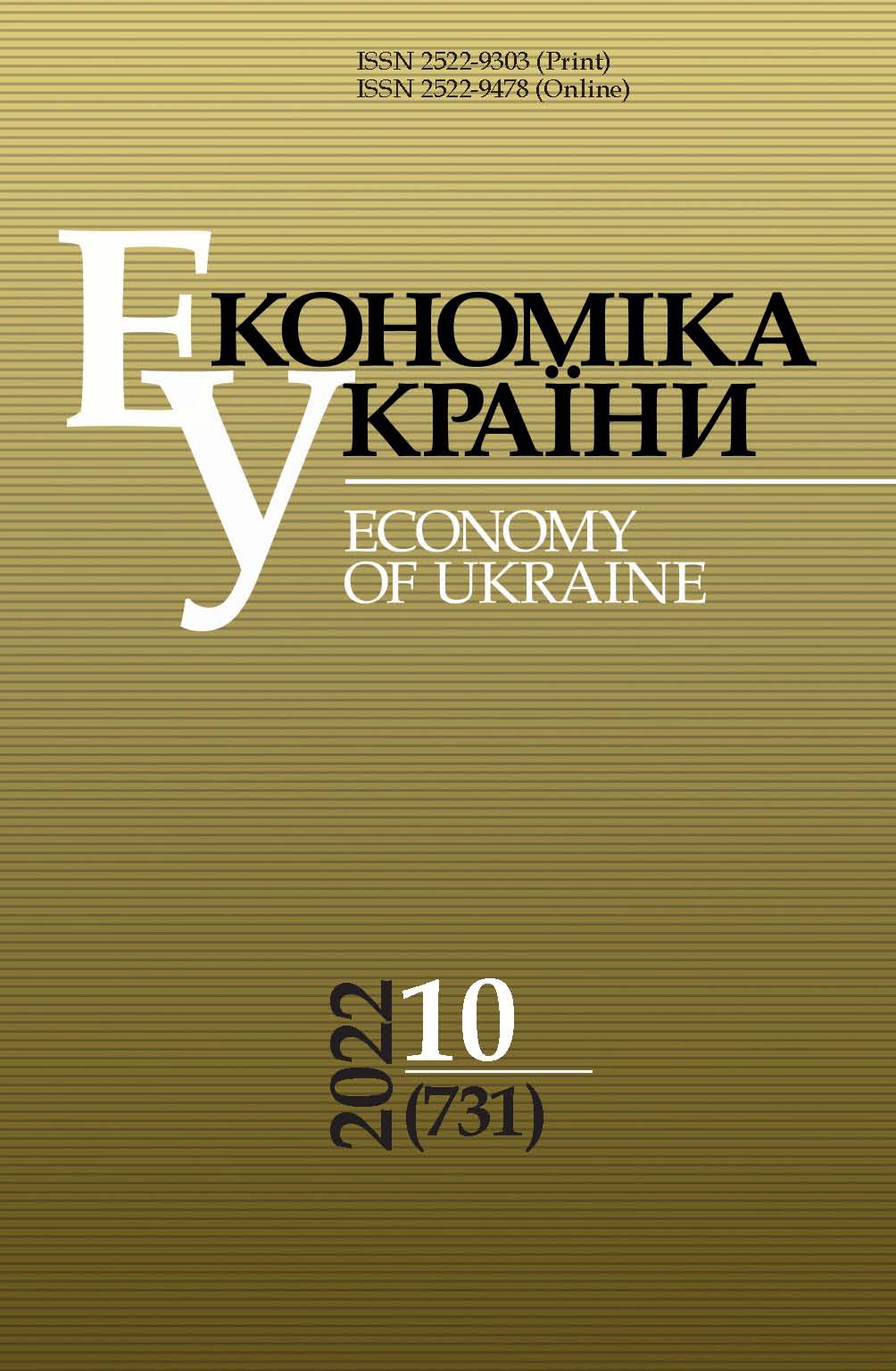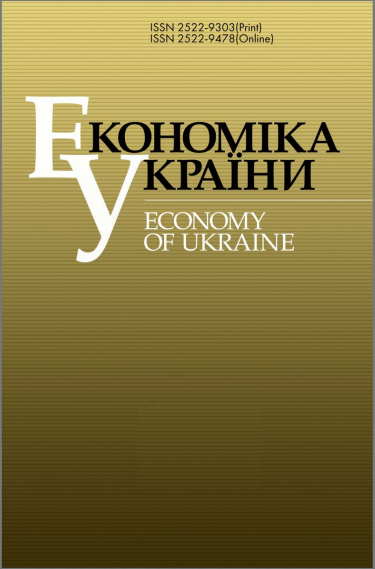STRENGTHENING FOREIGN EXCHANGE REGULATION IN UKRAINE AMID THE ESCALATION OF HOSTILITIES
DOI:
https://doi.org/10.15407/economyukr.2022.10.035Keywords:
exchange rate; monetary and credit policy; currency restrictions; the balance of payments; cross-border capital flowsAbstract
The relevance of using the potential of foreign exchange regulation in Ukraine in time of war and post-war economic reconstruction is substantiated. Using the example of the National Bank of Ukraine’s foreign exchange regulation measures in wartime, the efficiency of foreign exchange restrictions for curbing panic and speculative interests, preventing domestic capital’s flight and general stabilization of national currency’s exchange rate has been confirmed. It is noted that the measures to stabilize the exchange rate could have been more efficacious if they had been implemented within the framework of efficient foreign exchange regulation system.
Based on Ukraine’s balance of payments data indicated sources of devaluation pressure in the forms of: trade credits going abroad, import of services, and withdrawal of cash currency from hryvnia card accounts. The signs of impairment in the balance of payments structure due to a decrease in income from product exports and remittances that are replaced by international financial aid are outlined.
The identified threats confirm the need to develop a domestic system of foreign exchange regulation and supervision to prevent the withdrawal of domestic capital, limit speculative and panic demand for foreign currency, and increase supply on the foreign exchange market. It is noted that the strengthening of measures to stabilize the national currency fully corresponds to the current views of scientists, the recommendations of international financial institutions and the requirements of European integration, especially considering the circumstances of the war.
The primary areas of development of the foreign exchange regulation system are conceptualized, including the official recognition of the need for such a system and expansion of the foreign exchange supervision system’s functionality, an emphasis on limiting speculative and panic demand, the fight against illicit ways of withdrawing capital abroad. An effective toolkit for such regulation should include a wide range of measures, including the use of macroprudential policy tools, control over capital flows and currency interventions on a long-term basis, prompt use of administrative requirements to secure identified ways of avoiding established restrictions.
References
Fleming J.M. Domestic financial policies under fixed and floating exchange rates. IMF Staff Papers, 1962, Vol. 9, pp. 369-379.
doi.org/10.2307/3866091
Mundell R. Capital mobility and stabilization policy under fixed and flexible exchange rates. Canadian Journal of Economic and Political Science, 1963, Vol. 29, No. 4, pp. 475-485.
doi.org/10.2307/139336
Rey H. Dilemma not Trilemma: The Global Financial Cycle and Monetary Policy Independence. NBER Working paper series, 2015, pp. 1-42, available at: www.nber.org/system/files/working_papers/w21162/w21162.pdf
doi.org/10.3386/w21162
Farhi E., Werning І. Dilemma not trilemma? Capital controls and exchange rates with volatile capital flows. IMF Economic Review, 2014, No. 62, pp. 569-605, available at: www.jstor.org/stable/43297892
doi.org/10.1057/imfer.2014.25
Bekaert G., Mehl A. On the global financial market integration «Swoosh» and the Trilemma. NBER Working Papers, 2017, No. 23124, available at: ideas.repec.org/p/nbr/nberwo/23124.html
doi.org/10.3386/w23124
Eichengreen B. The Endogeneity of Exchange-Rate Regimes. In: Understanding Interdependence. Princeton University Press, 2021, pp. 3-33.
doi.org/10.2307/j.ctv1h9dhc9.6
Aizenman J., Chinn M., Ito H. The Emerging Global Financial Architecture: Tracing and Evaluating the New Patterns of the Trilemma's Configurations. Journal of International Money and Finance, 2010, Vol. 29, No. 4, pp. 615-641, available at: web.pdx.edu/~ito/Aizenman_Chinn_Ito_hi_Oct7_2009.pdf
doi.org/10.1016/j.jimonfin.2010.01.005
Aizenman J., Chinn M., Ito H. The 'Impossible Trinity' Hypothesis in an Era of Global Imbalances: Measurement and Testing. Review of International Economics, 2013, Vol. 21, No. 3, pp. 447-458.
doi.org/10.1111/roie.12047
Ghosh A.R., Ostry J.D., Chamon M. Two targets, two instruments: Monetary and exchange rate policies in emerging market economies. Journal of International Money and Finance, 2016, Vol. 60, pp. 172-196.
doi.org/10.1016/j.jimonfin.2015.03.005
Bereslavska O.I. Currency policy in conditions of inflation targeting in Ukraine. Proceedings of the University of the State Fiscal Service of Ukraine, 2017, No. 2, pp. 24-36 [in Ukrainian].
Halchynskyi A.S. The Theory of Money. Kyiv, 2001 [in Ukrainian].
Dzyublyuk O. Foreign exchange policy as a macroeconomic stabilization factor. Finance of Ukraine, 2016, No. 11, pp. 33-51 [in Ukrainian].
Zhuravka F.O. Mechanism for the implementation of currency policy in Ukraine. Dr. Sci. (Econ.) Thesis. Sumy, 2009 [in Ukrainian].
Korablin S.O. Macroeconomic dynamics of Ukraine: the commodity markets trap. Kyiv, 2017 [in Ukrainian].
Shapoval Yu.I. Capital flows control: features of innovative approaches and insights for Ukraine. Ukrainian Society, 2018, No. 2, pp. 102-129 [in Ukrainian].
doi.org/10.15407/socium2018.02.106
Kaminsky G. Boom-bust capital flow cycles. National Bureau of Economic Research, May 2019. Working Paper 25890, available at: www.nber.org/system/files/working_papers/w25890/w25890.pdf
doi.org/10.3386/w25890
Goldberg L., Krogstrup S. International capital flow pressures. IMF Working Papers, 2018, No. WP/18/30, available at: www.imf.org/en/Publications/WP/Issues/2018/02/16/International-Capital-Flow-Pressures-45629
doi.org/10.5089/9781484341803.001
Gagnon J. Flexible Exchange Rates for a Stable World Economy. Peterson Institute, 2011.
Ghosh A., Ostry J., Qureshi M. Policy responses to capital flows in emerging markets: Some new evidence. Vox Portal, 2017, available at: voxeu.org/article/policy-responses-capital-flows-emerging-markets (accessed on: 16.07.2022).
Lim C., Columba F., Costa A. et al. Macroprudential policy: what instruments and how to use them? Lessons from country experiences. IMF Working Papers, 2011, WP/11/238.
doi.org/10.5089/9781463922603.001
Bublyk Ye.O. Financial openness of transitive economies. Kyiv, 2020 [in Ukrainian].
Danylenko A.I. Fiscal-budgetary and monetary and credit policy of Ukraine: problems and ways to strengthen the relationship. Kyiv, 2010 [in Ukrainian].
Downloads
Published
How to Cite
Issue
Section
License
Copyright (c) 2022 Institute for Economics and Forecasting of the NAS of Ukraine

This work is licensed under a Creative Commons Attribution-NonCommercial-NoDerivatives 4.0 International License.



